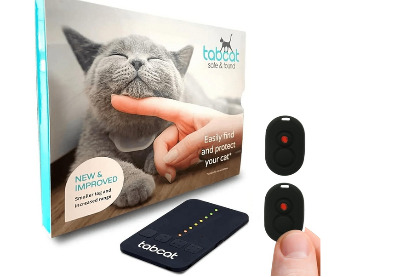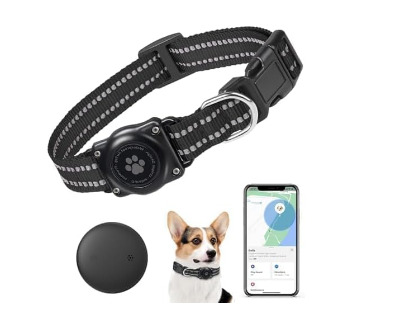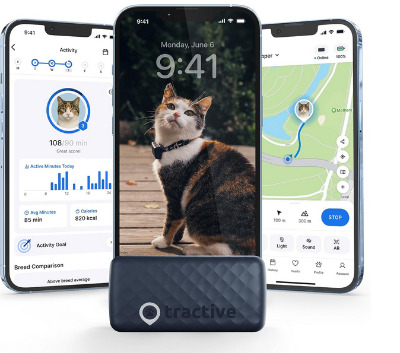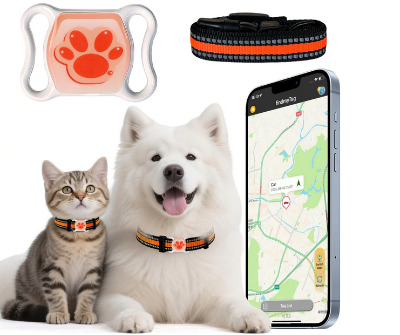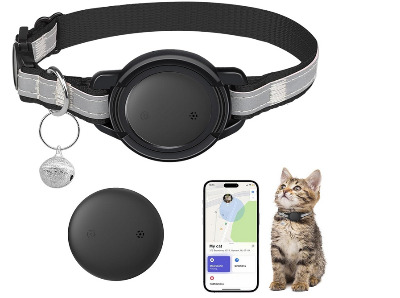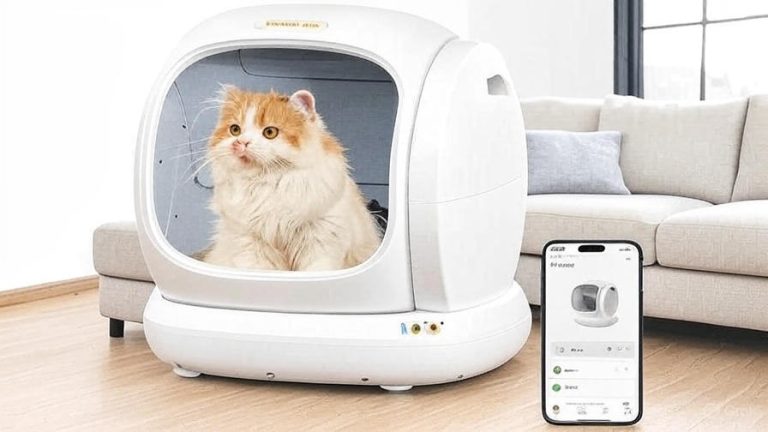5 Best Cat GPS Tracker In 2025
Cats are curious creatures. They love to explore, wander, and sometimes disappear for hours at a time. As a cat owner, you know that sinking feeling when your feline friend doesn’t come home at their usual time. This is where cat GPS trackers become absolute lifesavers.
Finding the right tracking device for your cat can feel overwhelming. The market offers dozens of options, each promising to be the ultimate solution. Some use traditional GPS technology, while others rely on radio frequency signals. Some demand monthly subscriptions, while others operate without any recurring fees.
This guide examines five top-performing cat tracking devices. We’ve researched their features, tested their accuracy, and evaluated their real-world performance. Our goal is simple: help you find the perfect tracker that keeps your beloved cat safe without breaking the bank.
Why Your Cat Needs a GPS Tracker
Before diving into specific products, let’s talk about why these devices matter. Cats are natural explorers. Even indoor cats can bolt through open doors or slip out through windows. Once outside, they can travel surprising distances in a short time.
Traditional methods like microchips only work if someone finds your cat and takes them to a vet or shelter. Collars with ID tags are helpful, but they don’t tell you where your cat is right now. GPS trackers bridge this gap by providing real-time location data.
These devices offer peace of mind. You can check your cat’s location anytime from your smartphone. Many trackers also create safe zones and send alerts when your cat leaves designated areas. Some even monitor your cat’s activity levels, helping you spot potential health issues early.
Understanding Different Tracking Technologies
Not all cat trackers use the same technology. This distinction matters because it affects accuracy, range, and subscription requirements.
Radio Frequency Trackers
These devices use radio waves instead of GPS satellites. They work like a high-tech game of hot and cold. You carry a handheld receiver that beeps faster as you get closer to your cat. The main advantage is pinpoint accuracy at close range. The downside is limited range, typically around 400-500 feet. However, walls and obstacles don’t interfere as much as they do with GPS signals.
GPS Trackers
Traditional GPS trackers use satellite signals to pinpoint your cat’s location. They can track over unlimited distances, as long as cellular coverage exists. These devices show your cat’s location on a smartphone app. Most require monthly subscriptions to maintain cellular connectivity. Battery life varies but typically lasts a few days between charges.
Apple AirTag-Compatible Trackers
These newer devices piggyback on Apple’s Find My network. They don’t need monthly subscriptions because they use nearby Apple devices to relay location data. The catch is they only work with iOS devices and rely on the density of Apple users in your area. In urban settings, they work remarkably well. In rural areas, updates may be less frequent.
Top 5 Cat GPS Trackers Reviewed
1. Tabcat V2 Cat & Kitten Tracker – The Precision Champion
The Tabcat V2 takes a different approach from most cat trackers. Instead of relying on GPS satellites, it uses radio frequency technology to deliver exceptional accuracy.
Product Description
This system includes two lightweight tags, protective cases, and a handheld tracking device. Each tag weighs only 6 grams, making it perfect for cats and even kittens over 6 months old. The tracker works both indoors and outdoors, with an effective range of up to 500 feet. The handset uses directional beeping to guide you toward your cat’s location. As you get closer, the beeps intensify, helping you pinpoint your cat’s position within one inch.
The device requires no monthly subscription fees. Once you purchase it, you own it outright with no hidden costs. The tags use replaceable batteries that last approximately one year under normal use. The system can track two cats simultaneously, making it ideal for multi-cat households.
Key Features
The directional beeping system sets Tabcat apart from competitors. Instead of viewing a map on your phone, you follow audio cues that grow louder and faster as you approach your cat. This proves especially valuable in dense urban environments or areas with poor cellular coverage.
The lightweight design ensures your cat won’t feel burdened. Many cats refuse to wear heavy GPS collars, but the Tabcat tag is so light they barely notice it. The compact size also reduces the risk of the tag catching on branches or fences during outdoor adventures.
Indoor tracking capability gives Tabcat a significant edge. GPS signals often fail inside buildings, but radio frequency waves penetrate walls effectively. You can find your cat hiding in closets, under beds, or even in neighbors’ garages.
Pros
- No monthly subscription fees save money over time
- Exceptional accuracy up to one inch precision
- Extremely lightweight tags suitable for kittens
- Works reliably indoors where GPS fails
- Can track two cats with one handset
- Long battery life with easy replaceable batteries
- No need for smartphone or cellular coverage
- Directional beeping guides you precisely to your cat
Cons
- Limited range of 500 feet compared to GPS trackers
- Requires carrying a separate handset device
- No smartphone app for remote monitoring
- Range decreases in areas with many obstacles
- Cannot track beyond the 500-foot range limit
Best For
This tracker suits cat owners who live in apartments, suburban neighborhoods, or areas with poor cellular coverage. It’s perfect for finding cats hiding in nearby locations rather than tracking long-distance wanderers. The lack of subscription fees makes it economical for long-term use.
2. Mini GPS Cat Tracker for Apple Find My – The Budget-Friendly Option
This compact tracker leverages Apple’s Find My network to deliver location tracking without monthly fees. It represents a new generation of tracking devices that democratize pet tracking technology.
Product Description
This single-pack tracker integrates seamlessly with Apple’s Find My ecosystem. It attaches easily to your cat’s collar and connects to your iPhone or iPad within seconds. The device uses Bluetooth technology combined with the vast network of Apple devices worldwide to report your cat’s location.
The tracker includes anti-lost features that trigger alerts when your cat moves beyond a designated safe zone. You can set up multiple safe zones for different locations like home, a vacation property, or a regular outdoor play area. The compact design keeps weight minimal, though it’s slightly larger than an AirTag.
Battery life depends on usage patterns but typically lasts several weeks. The device charges via USB-C cable, and low battery notifications prevent unexpected power loss. The tracker is water-resistant, protecting against rain and accidental water exposure.
Key Features
Integration with Apple Find My eliminates the need for separate apps or subscriptions. Your cat’s tracker appears alongside your other Apple devices in the Find My app. You can play a sound from the tracker to help locate your cat in nearby hiding spots.
The crowd-sourced finding capability means any Apple device can anonymously relay your cat’s location to you. In populated areas, this creates an extensive tracking network without any infrastructure costs. The system maintains privacy by encrypting all location data.
The device supports both iOS-based tracking and can be used to track vehicles, bags, or other items. This versatility means you’re not limited to pet tracking alone. Many users purchase multiple units for different purposes.
Pros
- Zero monthly subscription fees
- Works with existing Apple Find My app
- Lightweight and compact design
- Water-resistant construction
- Multiple safe zone alerts
- Rechargeable battery
- Anonymous crowd-sourced tracking network
- Affordable entry price point
Cons
- Only compatible with iOS devices
- Effectiveness depends on nearby Apple device density
- Less reliable in rural or remote areas
- Cannot provide continuous real-time tracking
- Location updates may have delays
- Not as accurate as dedicated GPS systems
Best For
iPhone and iPad users living in urban or suburban areas will get the most from this tracker. It’s excellent for cat owners who want basic tracking capability without ongoing costs. The device works best for cats that stay relatively close to home rather than long-distance roamers.
3. Tractive Smart Cat GPS Tracker – The Premium Powerhouse
Tractive has built a reputation for reliable pet tracking, and their cat-specific model delivers comprehensive features for serious cat owners.
Product Description
This dedicated cat GPS tracker combines real-time location tracking with wellness monitoring features. The device attaches to the included breakaway collar, which releases automatically if your cat gets snagged on something. This safety feature prevents choking hazards while maintaining tracking capability.
The tracker uses both GPS and cellular technology to pinpoint your cat’s location anywhere with network coverage. Location updates occur in real-time, showing you exactly where your cat is at any moment. The accompanying app displays your cat’s position on detailed maps with satellite and terrain views.
Battery life extends up to five days depending on usage patterns. The device uses a proprietary charging cable and includes battery optimization features. Power-saving modes extend battery life when full tracking isn’t necessary.
The tracker only works with cats weighing 6.5 pounds or more. This weight requirement ensures the collar and device don’t burden smaller cats or kittens.
Key Features
The wellness monitoring system tracks your cat’s activity levels, sleep patterns, and overall movement. The app generates reports showing daily, weekly, and monthly trends. These insights help identify changes in behavior that might indicate health issues.
Virtual fence technology creates unlimited safe zones. You receive instant notifications when your cat enters or leaves designated areas. This feature proves invaluable for monitoring outdoor time or ensuring your cat stays within your property boundaries.
Location history allows you to review where your cat has been throughout the day. The app creates heatmaps showing your cat’s favorite spots and regular routes. This territorial insight helps you understand your cat’s behavior patterns and favorite hangouts.
The live tracking mode provides second-by-second location updates. When your cat is missing, this feature helps you follow their movement in real-time. The mode consumes more battery but proves critical during active searches.
Pros
- True real-time GPS tracking with live updates
- Comprehensive wellness and activity monitoring
- Unlimited virtual fences and safe zones
- Detailed location history and territory mapping
- Five-day battery life with optimization options
- Breakaway collar included for safety
- Works with cats 6.5 pounds and larger
- Reliable cellular connectivity in most areas
Cons
- Requires monthly subscription fee
- Heavier than radio frequency alternatives
- Not suitable for small cats under 6.5 pounds
- Battery needs regular recharging
- Subscription costs add up over time
- May feel bulky for some cats
Best For
This tracker suits dedicated cat owners who want comprehensive monitoring beyond basic location tracking. It’s ideal for cats with outdoor access in areas with good cellular coverage. The wellness features appeal to owners who treat their cats like family members and want detailed health insights.
4. Pet GPS Tracker with No Monthly Fee – The Long-Distance Solution
This tracker promises extensive coverage without the burden of ongoing subscription costs. It positions itself as the ultimate value proposition for budget-conscious cat owners.
Product Description
The device comes with a free collar included, ready to attach and use immediately. It features waterproof construction rated for full submersion, protecting against rain, puddles, and even swimming. The tracker uses a combination of GPS, Wi-Fi, and cellular technology to maintain location accuracy.
The standout feature is the 365-day battery life claim. This extended battery duration eliminates the hassle of frequent recharging that plagues most GPS trackers. The device uses power-efficient location tracking that balances accuracy with battery conservation.
Compatibility spans both iOS and Android platforms. The dedicated app provides map views, location history, and safe zone alerts. Real-time tracking shows your cat’s current position with regular updates throughout the day.
The waterproof rating means you don’t need to remove the tracker during rainy weather. Cats who enjoy exploring in all conditions can wear it continuously without damage concerns.
Key Features
The year-long battery life fundamentally changes the tracking experience. You can set it and forget it without worrying about daily or weekly charging sessions. This convenience factor makes it practical for long-term use without maintenance headaches.
Anti-lost technology sends immediate alerts when your cat leaves designated safe zones. You can create multiple zones for different locations and adjust their size to match your property boundaries. The alerts include map links showing exactly where your cat crossed the boundary.
Cross-platform compatibility means family members with different phone types can all monitor your cat’s location. The app syncs across devices, so everyone stays informed about your cat’s whereabouts.
The included collar eliminates the need for separate purchases. The collar features adjustable sizing to fit cats of various sizes and includes breakaway safety features.
Pros
- No monthly subscription fees
- Impressive 365-day battery life
- Fully waterproof construction
- Free collar included
- Compatible with both iOS and Android
- Real-time location tracking
- Multiple safe zone alerts
- Long-term cost savings
Cons
- Initial purchase price higher than some alternatives
- Battery replacement after one year may be costly
- Some users report inconsistent location accuracy
- Customer service responsiveness varies
- App interface less polished than premium options
- May be heavier than radio frequency trackers
Best For
Cat owners who want GPS capability without monthly fees will appreciate this device. It suits those who prioritize convenience and hate frequent charging. The waterproof design makes it perfect for cats who explore in all weather conditions.
5. GPS Tracker for Cats with Apple Find My – The Smart Integration Pick
This tracker combines the convenience of Apple’s ecosystem with practical pet tracking features. It represents the second generation of Find My-compatible pet trackers.
Product Description
The device connects instantly to Apple Find My network, appearing in your app alongside AirTags and other tracked items. Setup takes less than a minute, requiring only Bluetooth pairing with your iPhone. The tracker then leverages the global network of Apple devices to report location data.
Smart pet activity tracking monitors your cat’s movement patterns throughout the day. The app displays activity summaries showing active periods, rest times, and overall movement. While not as comprehensive as dedicated wellness platforms, it provides useful baseline activity information.
The anti-lost finder tag functionality extends beyond pet tracking. You can attach it to keys, bags, or vehicles when not using it for your cat. This versatility maximizes value from a single device purchase.
Water resistance protects against typical outdoor exposure like rain and wet grass. The compact design minimizes weight while maintaining durability. The device recharges via standard USB-C cables that most households already own.
Key Features
Apple Find My integration means you’re using proven technology with massive infrastructure support. The network includes billions of Apple devices worldwide, creating extensive coverage in populated areas. The system maintains privacy through end-to-end encryption.
Activity tracking provides basic insights into your cat’s daily routine. You can spot unusual patterns that might indicate health concerns or changes in behavior. The data displays in simple graphs and charts that require no technical knowledge to interpret.
The precision finding feature available on iPhone 11 and newer models uses ultra-wideband technology. This capability guides you to your cat with arrow directions and distance measurements when you’re within Bluetooth range. The combination of network finding and precision finding covers both long-distance and close-range scenarios.
Battery notifications ensure you never experience unexpected power loss. The device sends alerts when charge drops below 20%, giving you plenty of time to recharge.
Pros
- No monthly subscription required
- Seamless Apple ecosystem integration
- Basic activity tracking included
- Precision finding on compatible iPhones
- Compact and lightweight design
- Water-resistant construction
- USB-C charging convenience
- Multi-purpose use beyond pet tracking
Cons
- iOS devices required
- Performance varies by area
- Not suitable for real-time continuous tracking
- Location updates may lag in sparse areas
- Less accurate than dedicated GPS trackers
- Relies on other Apple users nearby
Best For
Apple users who want affordable tracking without subscriptions will find this device appealing. It works best in urban and suburban environments with high Apple device density. The activity tracking bonus makes it valuable for monitoring overall cat wellness at a basic level.
How to Choose the Right Cat GPS Tracker
Selecting the perfect tracker for your cat depends on several personal factors. Let’s break down the key considerations that should guide your decision.
Your Cat’s Size and Weight
Smaller cats and kittens need extremely lightweight trackers. Devices over 10-15 grams can burden tiny cats and affect their natural movement. Radio frequency trackers like Tabcat typically weigh less than GPS units. Always check weight requirements before purchasing, especially for cats under 8 pounds.
Your Living Environment
Urban dwellers benefit from cellular GPS trackers and Apple Find My devices because of excellent network coverage and high device density. Rural cat owners might struggle with cellular GPS trackers due to spotty coverage. Radio frequency trackers work equally well everywhere because they don’t depend on infrastructure.
Your Cat’s Roaming Habits
Indoor cats who occasionally escape need different tracking than outdoor adventurers. Indoor-focused cats rarely travel beyond 500 feet from home, making radio frequency trackers perfect. Outdoor cats with large territories require GPS trackers that work over unlimited distances.
Budget Considerations
Calculate total cost over time, not just initial purchase price. A $100 tracker with no monthly fees costs less than a $30 tracker with $10 monthly subscriptions after one year. Subscription-free options save hundreds of dollars over a pet’s lifetime.
Radio frequency trackers and Apple Find My devices eliminate recurring costs. Traditional GPS trackers typically charge $5-15 monthly for cellular service. Consider how many cats you’re tracking, as subscription costs multiply with multiple pets.
Technology Preferences
Tech-savvy iPhone users might prefer Apple Find My integration that works with their existing ecosystem. Those who like standalone devices might appreciate radio frequency trackers with dedicated handsets. Cat owners who want the latest features and wellness monitoring should consider premium GPS options with companion apps.
Accuracy Requirements
If you need pinpoint accuracy to find your cat hiding in dense bushes or under decks, radio frequency trackers excel. Their directional beeping guides you to within inches of your cat’s location. GPS trackers typically offer 5-30 foot accuracy, enough to get you to the right yard but not the exact hiding spot.
Battery Life Expectations
Decide how often you’re willing to charge the device. Some trackers need charging every few days, while others last weeks or even months. Consider your lifestyle and whether you’ll remember regular charging. Longer battery life means less maintenance but often comes with reduced feature sets.
Setting Up Your Cat GPS Tracker
Proper setup ensures your tracking device works optimally from day one. Here’s how to get started with any cat tracker.
Initial Configuration
Unbox your device and fully charge it before first use. Most trackers arrive with partial charges, but starting with full battery ensures successful setup. Download the required app or prepare the handset according to manufacturer instructions.
Create your account using a valid email address. This account becomes critical if you need to access your cat’s location from multiple devices or recover lost login credentials. Use a strong password that you’ll remember.
Collar Attachment
Attach the tracker securely to a proper cat collar. Always use breakaway collars designed specifically for cats. These safety collars release under pressure, preventing choking if your cat gets snagged on branches or fences.
Position the tracker on the front or side of the collar where it won’t slide underneath your cat’s chest. Ensure it sits flat against the collar without twisting. Check that you can fit two fingers between the collar and your cat’s neck for proper fit.
Safe Zone Creation
Set up safe zones around your property boundaries. Most apps allow you to draw custom shapes or create circular zones with adjustable radius. Include your entire property plus a small buffer zone to account for GPS accuracy variations.
Create additional zones for locations your cat visits regularly, like a neighbor’s yard where they’re welcome. This helps distinguish between normal wandering and true disappearances.
Test the alerts by taking the tracker outside your safe zone. Verify that you receive notifications promptly and that they include the tracker’s location. If alerts don’t arrive, check your phone’s notification settings and app permissions.
Testing and Verification
Conduct test walks before your cat actually wears the device. For GPS trackers, verify that location updates appear correctly on your map. For radio frequency trackers, practice using the directional beeping at various distances.
Hide the tracker in your yard or home and practice finding it. This familiarizes you with how the device works before you’re searching for an actually missing cat. The practice reduces panic and improves search efficiency during real emergencies.
Check battery life indicators daily for the first week. This establishes baseline expectations for how long charges last under normal conditions. Note any rapid battery drain that might indicate device defects.
Maximizing Your Tracker’s Effectiveness
Owning a tracker is just the first step. Using it effectively requires ongoing attention and best practices.
Regular Maintenance
Check the collar fit weekly as cats can lose or gain weight. A loose collar allows the tracker to slip off, while a tight collar causes discomfort. Your cat’s fur can also bunch under the collar, creating false tightness.
Clean the tracker monthly with a damp cloth. Dirt and debris can interfere with sensors or charging contacts. Avoid submerging devices unless they’re rated for full waterproof protection. Water-resistant doesn’t mean waterproof.
Replace batteries or recharge devices according to the manufacturer’s schedule. Don’t wait until batteries die completely. Low battery can reduce tracking range or cause unexpected shutdowns during emergencies.
Monitoring Patterns
Review your cat’s location history regularly to learn their normal patterns. Notice their favorite outdoor spots, regular routes, and typical ranging distance. This baseline knowledge helps identify unusual behavior quickly.
Track seasonal changes in roaming behavior. Cats often expand their territory during spring breeding season and contract it during winter. Knowing these patterns prevents false alarm panic over normal behavior changes.
Note times when your cat is most active. Most cats have dawn and dusk activity peaks. Checking your tracker during these high-activity periods gives you better information than checking during typical nap times.
Emergency Preparedness
Keep your tracker fully charged during storms, fireworks holidays, or other events that might scare your cat into running. These predictable stress events account for many lost cat incidents.
Have a search plan ready before you need it. Know which neighbors you’ll contact, which direction you’ll search first, and who can help. This preparation cuts response time during actual emergencies.
Save important phone numbers in your contacts, including local animal control, nearby veterinary emergency clinics, and animal shelters. During a cat crisis, you don’t want to waste time searching for contact information.
Take current photos of your cat regularly. Updated photos help you create found-pet posters and verify your cat’s identity if someone finds them. Include photos showing unique markings or features.
Common Cat Tracker Problems and Solutions
Even the best trackers encounter occasional issues. Here’s how to troubleshoot common problems.
Weak or Intermittent Signal
GPS trackers need clear sky views to receive satellite signals. Thick tree cover, tall buildings, or indoor locations can block signals. If location accuracy seems poor, check if your cat is in a signal-obstructed area.
For Apple Find My devices, sparse location updates usually mean few Apple devices are nearby. This problem resolves automatically when your cat moves to more populated areas. In rural settings, consider switching to a dedicated GPS or radio frequency tracker.
Radio frequency trackers can experience interference from other electronic devices. Microwave ovens, Wi-Fi routers, and baby monitors sometimes create interference. Move away from these devices during tracking to improve signal clarity.
Rapid Battery Drain
Excessive battery consumption often indicates the tracker is searching constantly for signals. GPS devices drain fastest when moving rapidly or in areas with poor satellite visibility. Enable power-saving modes during normal conditions and reserve high-frequency tracking for emergencies.
Cold weather dramatically reduces battery life in all electronic devices. In winter, expect 20-50% shorter battery duration. Some manufacturers provide battery performance curves showing expected life at different temperatures.
Check if background app refresh is causing unnecessary battery drain on your phone. The tracker itself might be fine, but constant app checking depletes your phone’s battery. Adjust app settings to balance updates with power consumption.
Collar Rejection
Some cats initially resist wearing collars and trackers. Introduce the collar gradually, letting your cat wear it for a few minutes daily. Gradually increase duration over several days or weeks. Reward your cat with treats while wearing the collar to create positive associations.
If your cat removes the collar repeatedly, verify proper fit. Collars that are too loose slide off easily, while tight collars irritate cats into removal attempts. The two-finger rule ensures proper tension.
Try different collar materials. Some cats prefer fabric over synthetic materials or vice versa. Lightweight nylon collars with flat buckles often work best for tracker attachment.
Inaccurate Location Data
GPS accuracy varies based on satellite constellation geometry and atmospheric conditions. Normal GPS can be off by 15-30 feet under ideal conditions and more during storms or solar activity. Accept that pinpoint accuracy isn’t always possible with satellite technology.
Calibrate your safe zones larger than you think necessary to account for GPS drift. A 50-foot buffer zone prevents false alerts caused by normal GPS wander while your cat stays home.
For radio frequency trackers, accuracy problems usually stem from user error rather than device issues. Practice using the directional beeping in non-emergency situations. Learn how the signal changes based on your movement and positioning.
The Future of Cat Tracking Technology
Tracking technology continues evolving rapidly. Understanding emerging trends helps you make future-proof purchasing decisions.
Smaller, Lighter Devices
Manufacturers constantly shrink components while extending battery life. Within a few seasons, expect trackers half the current size with double the battery capacity. Smaller devices mean even tiny kittens can wear trackers safely.
Flexible electronics may enable collar-integrated trackers that feel like normal fabric. This innovation would eliminate the “box on collar” design that some cats resist.
Enhanced Health Monitoring
Current wellness features track basic activity levels. Future generations will monitor heart rate, body temperature, and respiratory patterns. These medical-grade sensors could alert you to health emergencies before symptoms become obvious.
AI-powered analysis will identify patterns indicating specific health conditions. The technology might detect early kidney disease, diabetes, or arthritis based on movement and behavior changes.
Improved Battery Technology
Solid-state batteries promise longer life in smaller packages. Current lithium batteries may give way to new chemistries that hold more energy while remaining safe and lightweight.
Solar charging integration could extend battery life indefinitely in sunny climates. Tiny solar panels might trickle-charge devices during outdoor adventures, dramatically reducing recharge frequency.
Better Network Coverage
Low-Earth orbit satellite constellations will provide GPS tracking even in remote areas lacking cellular coverage. Services like Starlink’s potential pet tracker integration could eliminate the coverage gap that currently limits GPS trackers.
Next-generation Find My networks might include Android devices, creating denser tracking networks. Cross-platform compatibility would dramatically improve crowd-sourced tracking effectiveness.
Frequently Asked Questions
Do GPS trackers hurt cats?
No, properly fitted GPS trackers are completely safe for cats. The devices emit radio signals thousands of times weaker than cell phones. The main consideration is weight – trackers over 10-15 grams can burden small cats. Choose appropriately sized devices for your cat’s weight and always use breakaway collars to prevent choking hazards.
How accurate are cat GPS trackers?
GPS trackers typically offer 15-30 foot accuracy under ideal conditions. Radio frequency trackers provide superior precision, locating cats within one inch. Apple Find My devices fall between these extremes, with accuracy depending on nearby Apple device density. All tracking methods are accurate enough to get you to your cat’s general location, after which visual searching and calling complete the process.
Can I track my cat internationally?
Most GPS trackers work only in their home country due to cellular network limitations. Some premium services offer international roaming for additional monthly fees. Radio frequency trackers work anywhere since they don’t use cellular or satellite networks. If you travel internationally with your cat, verify your tracker’s compatibility before departing.
What if my cat is indoors and the tracker shows them outside?
GPS signals can drift, especially near buildings with reflective surfaces. This drift sometimes places stationary objects dozens of feet from their actual location. Check safe zone boundaries – a too-small zone combined with GPS drift causes false alerts. If alerts persist, investigate to ensure your cat isn’t actually escaping through an unknown route.
How long do cat tracker batteries last?
Battery life varies dramatically by device type. Radio frequency trackers last 6-12 months on replaceable batteries. Standard GPS trackers need recharging every 2-7 days. The advertised 365-day battery life devices balance between these extremes through power-efficient location sampling. Actual battery life depends on usage patterns, temperature, and signal strength.
Making Your Final Decision
You now have comprehensive information about five excellent cat tracking options. Each device excels in specific scenarios while having limitations in others.
The Tabcat V2 delivers unmatched precision for close-range finding without subscription costs. Its radio frequency technology works flawlessly indoors and doesn’t depend on cellular coverage. However, the 500-foot range limit means it’s unsuitable for cats who roam far from home.
Apple Find My compatible trackers offer incredible value for iPhone users in populated areas. Zero subscription fees and decent tracking make them attractive budget options. Rural users and Android owners should look elsewhere due to technological limitations.
The Tractive Smart Cat GPS Tracker provides premium features for dedicated cat parents. Real-time tracking, wellness monitoring, and detailed history justify the monthly subscription for many owners. The device feels purpose-built for cats rather than adapted from other tracking uses.
Subscription-free GPS trackers with extended battery life appeal to users who want low-maintenance solutions. The year-long battery claim dramatically reduces charging hassles. Verify accuracy and customer service quality through reviews before purchasing, as these factors vary among no-subscription GPS devices.
Consider your specific situation carefully. An urban apartment cat needs different tracking than a farm cat with acres to explore. Your technical comfort level, budget constraints, and cat’s behavior patterns all influence which tracker works best.
Start by defining your must-have features. Is subscription-free operation mandatory? Do you need real-time tracking or is periodic location checking sufficient? Does your cat’s small size require an ultra-lightweight device?
Compare your must-have list against each product’s specifications. Eliminate options that don’t meet critical requirements. From the remaining devices, choose based on secondary preferences like app quality, battery life, or additional features.
Remember that any tracker is better than none. Even a basic device dramatically improves your chances of recovering a lost cat compared to hoping for the best. The peace of mind alone justifies the investment for most cat owners.
Your cat depends on you for their safety. A GPS tracker extends your ability to protect them beyond your property boundaries. The small investment in tracking technology pays enormous dividends the first time your cat goes missing and you find them quickly instead of searching for days.
Take time to research, but don’t delay indefinitely. Cats don’t warn us before they disappear. Having a tracker installed and tested before you need it ensures you’re prepared for the unexpected. Your future self will thank you for taking action now while your cat is safely home.
The right tracker is waiting for you among these five excellent options. Evaluate your needs, consider your budget, and choose the device that best matches your situation. Your cat’s safety is worth the effort of making an informed decision.

